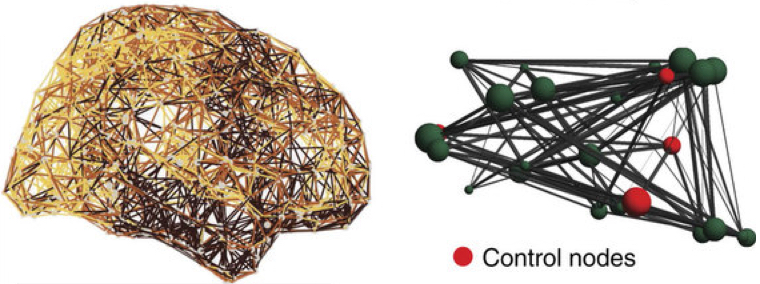How the brain’s wiring leads to cognitive control
October 5, 2015

From weighted brain networks (a), researchers estimate control points (b) whose large-scale regional activity can move the brain into new trajectories that traverse diverse cognitive functions (credit: Shi Gu et al./Nature Communications)
How does the brain determine which direction its thoughts travel? Looking for the mechanisms behind cognitive control of thought, researchers at the University of Pennsylvania, University of California, Riverside and Santa Barbara and United States Army Research Laboratory have used brain scans to shed new light on this question.
By using structural imaging techniques to convert brain scans into “wiring diagrams” of connections between brain regions, the researchers used the structure of these neural networks to reveal the fundamental rules that govern which parts of the brain are most able to exert “cognitive control” over thoughts and actions.
The work, published in an open-access paper in Nature Communications, weds cutting-edge neuroscience with the emerging field of network science, which is often used to study social systems. It applies control theory, a field traditionally used to study electrical and mechanical systems, to show that being on the “outskirts” of the brain is necessary for the frontal cortex to dynamically control the direction of thoughts and goal-directed behavior.
This fundamental understanding of how the brain controls its activity could help lead to better interventions for medical conditions associated with reduced cognitive control, such as autism, schizophrenia or dementia.
How the front cortex controls thoughts
According to Danielle Bassett, the Skirkanich Assistant Professor of Innovation in Penn’s School of Engineering and Applied Science and senior author on the study, “our results suggest that the human brain resembles a flock of birds. The flock comes to a consensus about which way to fly based on how close the birds are to one another and in what formation. Birds that fly at specific places in the flock can drive changes in the flock’s direction, being leaders in a so-called multi-agent system.
“Similarly, particular regions of your brain are predisposed to control your thoughts based on where they lie in relation to other regions.”
Cognitive psychologists and neuroscientists have long known that the frontal cortex is heavily involved in cognitive control. It is most active in experimental subjects asked to do tasks that require executive function, and damage to that region of the brain, through disease or injury, often results in loss of that function.
Applying control theory
The researchers were interested in developing a more fundamental understanding of how that region of the brain interacts with others to allow for executive function. Starting with detailed brain scans that show how neurons are physically connected to one another with one-millimeter precision, the scientists used a mathematical technique drawn from control theory in engineering.
By applying control theory equations to the “wiring diagrams” generated from brain scans, the researchers showed that the geographical and functional differences between regions of the brain are linked, with principles akin to large-scale dynamical network systems, such as power systems and robotic networks,
While the analysis cannot say whether the frontal cortex’s location or its role evolved first, it suggests that part of the frontal cortex’s ability to control executive function depends on its distance from other parts of the brain network.
Regions that are most interconnected, and therefore more internal to the network, are very good at moving the brain into nearby states, like from writing someone an email to talking to them on the phone. What’s particularly interesting is, if we look at where those inner nodes are, they’re all in ‘default mode’ regions, which are the regions that are active when you are resting. This makes sense, because if you were engineering an optimal system, you would want to put its baseline somewhere where it can get to most of the places it has to go pretty easily.”
This type of holistic understanding of the relationship between brain regions’ location and their roles is necessary for tailoring better treatments for people who have lost executive function due to disease or injury.
“We’re very interested in controlling brain networks with techniques like optogenetics, transcranial magnetic or direct-current stimulation, deep brain stimulation or even neurofeedback,” Bassett said, “but the problem has been that there is little theoretical basis to determine how these stimulations affect the dynamics of the whole brain. In most cases, stimulation is applied via trial and error. This research helps to build up an understanding of the impact of stimulation in one region on cognition as a whole.”
Future research will test whether “wiring” differences between people predict their performance on cognitive tasks. It will also underpin work on therapeutic and adaptive technologies that capitalize on brain networks’ unique advantages over their computerized counterparts.
Abstract of Controllability of structural brain networks
Cognitive function is driven by dynamic interactions between large-scale neural circuits or networks, enabling behaviour. However, fundamental principles constraining these dynamic network processes have remained elusive. Here we use tools from control and network theories to offer a mechanistic explanation for how the brain moves between cognitive states drawn from the network organization of white matter microstructure. Our results suggest that densely connected areas, particularly in the default mode system, facilitate the movement of the brain to many easily reachable states. Weakly connected areas, particularly in cognitive control systems, facilitate the movement of the brain to difficult-to-reach states. Areas located on the boundary between network communities, particularly in attentional control systems, facilitate the integration or segregation of diverse cognitive systems. Our results suggest that structural network differences between cognitive circuits dictate their distinct roles in controlling trajectories of brain network function.